ATA TESOL College: Adolescent English Teaching Assignment 1-3
VerifiedAdded on 2020/02/24
|16
|2840
|149
Homework Assignment
AI Summary
This document presents solutions to an adolescent English teaching assignment from ATA TESOL College. The assignment covers various aspects of teaching English to adolescents, including understanding adolescent development, creating a positive classroom environment, motivating students, and incorporating different teaching approaches. The solutions include answers to questions on adolescent behavior, cultural influences, and learning styles. Furthermore, the assignment includes detailed lesson plans using the communicative approach, video integration, and minimal pair activities. The lesson plans focus on specific language skills, incorporate various resources, and provide step-by-step instructions for teachers. Overall, the document offers a comprehensive guide to effectively teaching English to adolescent learners.

Student Assessment
Paraphrase This Document
Need a fresh take? Get an instant paraphrase of this document with our AI Paraphraser

©2006 ATA TESOL College English for Adolescents Ass.
V02/0611/MA
2
V02/0611/MA
2
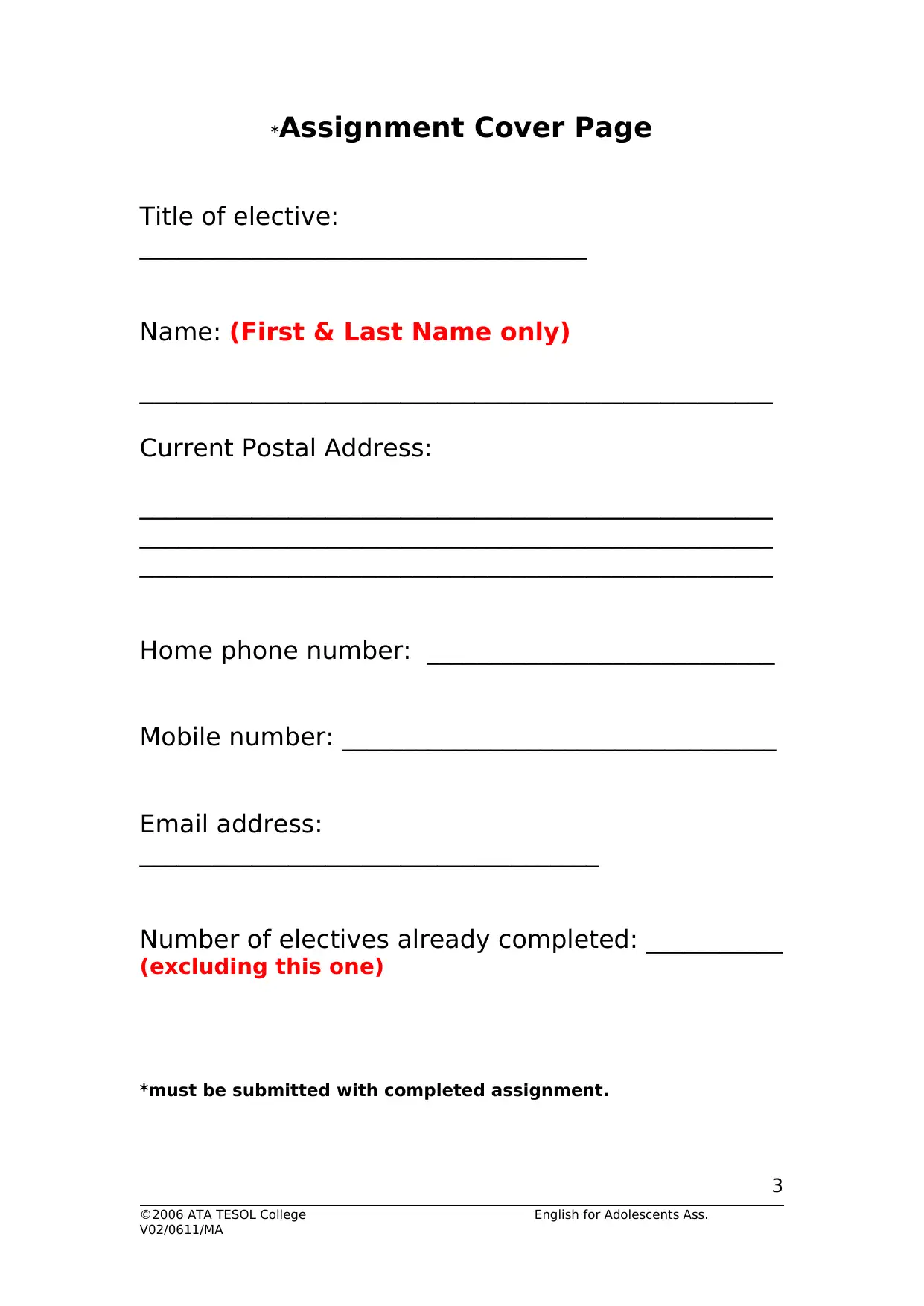
*Assignment Cover Page
Title of elective:
____________________________________
Name: (First & Last Name only)
___________________________________________________
Current Postal Address:
___________________________________________________
___________________________________________________
___________________________________________________
Home phone number: ____________________________
Mobile number: ___________________________________
Email address:
_____________________________________
Number of electives already completed: ___________
(excluding this one)
*must be submitted with completed assignment.
©2006 ATA TESOL College English for Adolescents Ass.
V02/0611/MA
3
Title of elective:
____________________________________
Name: (First & Last Name only)
___________________________________________________
Current Postal Address:
___________________________________________________
___________________________________________________
___________________________________________________
Home phone number: ____________________________
Mobile number: ___________________________________
Email address:
_____________________________________
Number of electives already completed: ___________
(excluding this one)
*must be submitted with completed assignment.
©2006 ATA TESOL College English for Adolescents Ass.
V02/0611/MA
3
⊘ This is a preview!⊘
Do you want full access?
Subscribe today to unlock all pages.

Trusted by 1+ million students worldwide
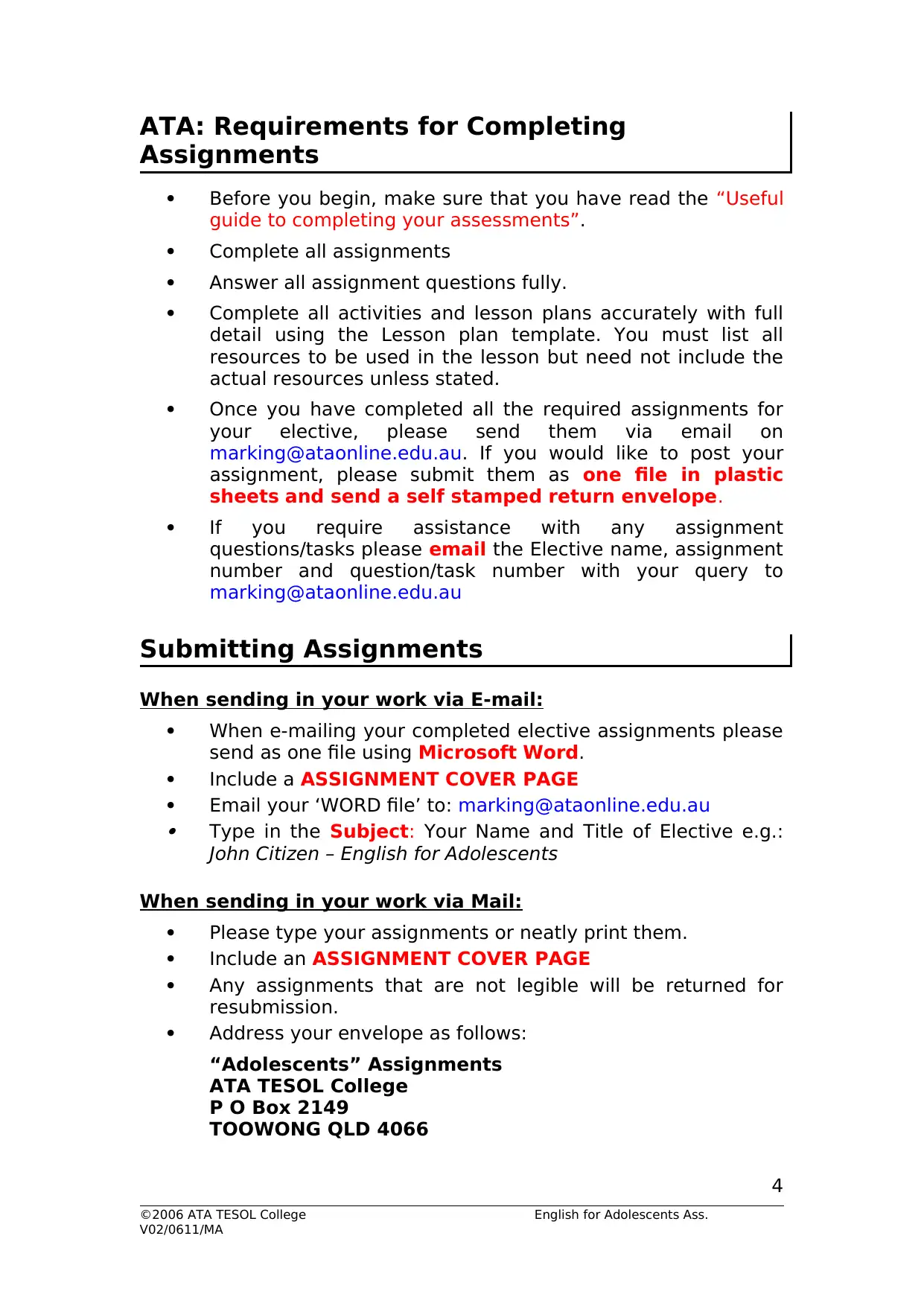
ATA: Requirements for Completing
Assignments
Before you begin, make sure that you have read the “Useful
guide to completing your assessments”.
Complete all assignments
Answer all assignment questions fully.
Complete all activities and lesson plans accurately with full
detail using the Lesson plan template. You must list all
resources to be used in the lesson but need not include the
actual resources unless stated.
Once you have completed all the required assignments for
your elective, please send them via email on
marking@ataonline.edu.au. If you would like to post your
assignment, please submit them as one file in plastic
sheets and send a self stamped return envelope.
If you require assistance with any assignment
questions/tasks please email the Elective name, assignment
number and question/task number with your query to
marking@ataonline.edu.au
Submitting Assignments
When sending in your work via E-mail:
When e-mailing your completed elective assignments please
send as one file using Microsoft Word.
Include a ASSIGNMENT COVER PAGE
Email your ‘WORD file’ to: marking@ataonline.edu.au
Type in the Subject: Your Name and Title of Elective e.g.:
John Citizen – English for Adolescents
When sending in your work via Mail:
Please type your assignments or neatly print them.
Include an ASSIGNMENT COVER PAGE
Any assignments that are not legible will be returned for
resubmission.
Address your envelope as follows:
“Adolescents” Assignments
ATA TESOL College
P O Box 2149
TOOWONG QLD 4066
©2006 ATA TESOL College English for Adolescents Ass.
V02/0611/MA
4
Assignments
Before you begin, make sure that you have read the “Useful
guide to completing your assessments”.
Complete all assignments
Answer all assignment questions fully.
Complete all activities and lesson plans accurately with full
detail using the Lesson plan template. You must list all
resources to be used in the lesson but need not include the
actual resources unless stated.
Once you have completed all the required assignments for
your elective, please send them via email on
marking@ataonline.edu.au. If you would like to post your
assignment, please submit them as one file in plastic
sheets and send a self stamped return envelope.
If you require assistance with any assignment
questions/tasks please email the Elective name, assignment
number and question/task number with your query to
marking@ataonline.edu.au
Submitting Assignments
When sending in your work via E-mail:
When e-mailing your completed elective assignments please
send as one file using Microsoft Word.
Include a ASSIGNMENT COVER PAGE
Email your ‘WORD file’ to: marking@ataonline.edu.au
Type in the Subject: Your Name and Title of Elective e.g.:
John Citizen – English for Adolescents
When sending in your work via Mail:
Please type your assignments or neatly print them.
Include an ASSIGNMENT COVER PAGE
Any assignments that are not legible will be returned for
resubmission.
Address your envelope as follows:
“Adolescents” Assignments
ATA TESOL College
P O Box 2149
TOOWONG QLD 4066
©2006 ATA TESOL College English for Adolescents Ass.
V02/0611/MA
4
Paraphrase This Document
Need a fresh take? Get an instant paraphrase of this document with our AI Paraphraser
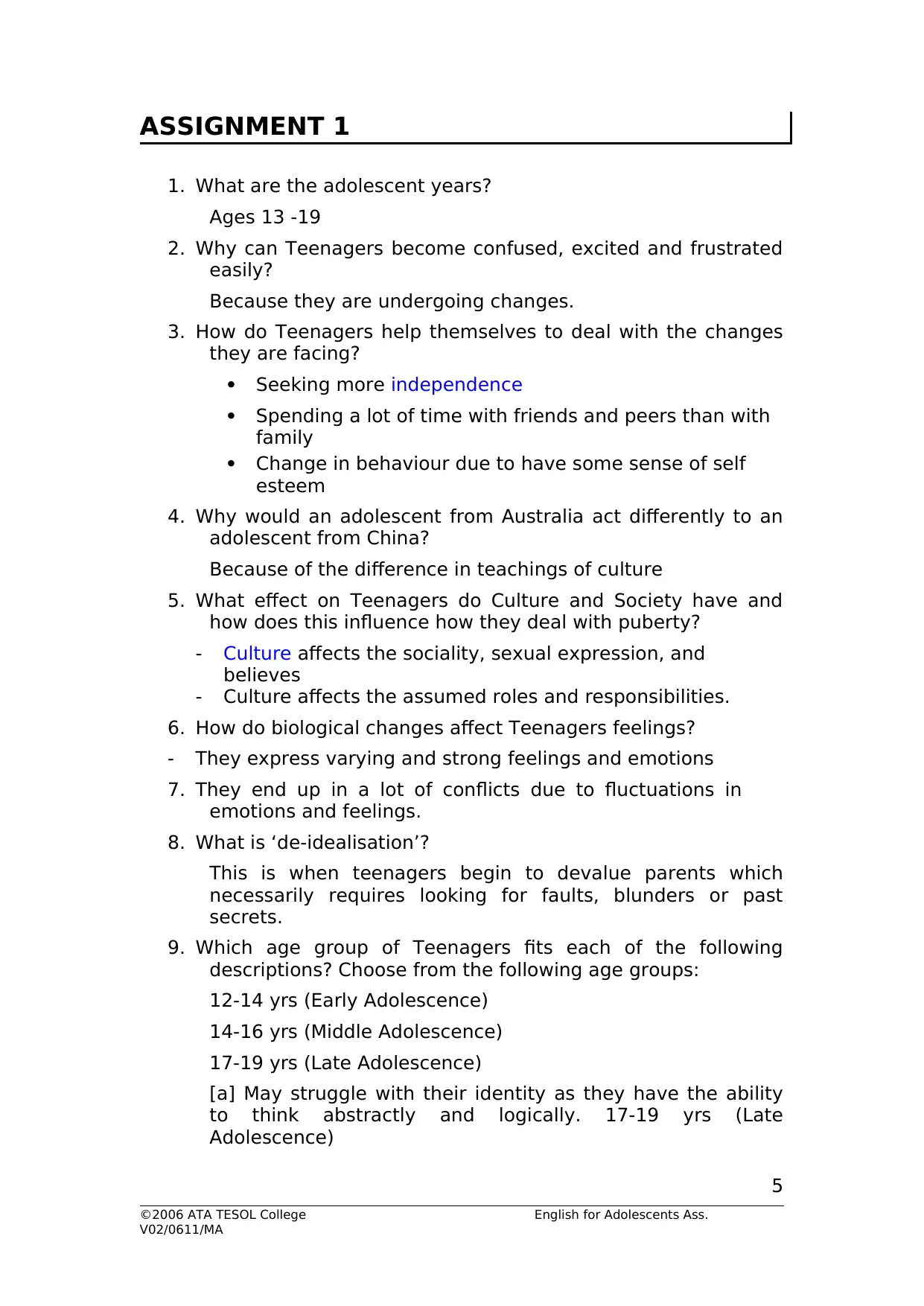
ASSIGNMENT 1
1. What are the adolescent years?
Ages 13 -19
2. Why can Teenagers become confused, excited and frustrated
easily?
Because they are undergoing changes.
3. How do Teenagers help themselves to deal with the changes
they are facing?
Seeking more independence
Spending a lot of time with friends and peers than with
family
Change in behaviour due to have some sense of self
esteem
4. Why would an adolescent from Australia act differently to an
adolescent from China?
Because of the difference in teachings of culture
5. What effect on Teenagers do Culture and Society have and
how does this influence how they deal with puberty?
- Culture affects the sociality, sexual expression, and
believes
- Culture affects the assumed roles and responsibilities.
6. How do biological changes affect Teenagers feelings?
- They express varying and strong feelings and emotions
7. They end up in a lot of conflicts due to fluctuations in
emotions and feelings.
8. What is ‘de-idealisation’?
This is when teenagers begin to devalue parents which
necessarily requires looking for faults, blunders or past
secrets.
9. Which age group of Teenagers fits each of the following
descriptions? Choose from the following age groups:
12-14 yrs (Early Adolescence)
14-16 yrs (Middle Adolescence)
17-19 yrs (Late Adolescence)
[a] May struggle with their identity as they have the ability
to think abstractly and logically. 17-19 yrs (Late
Adolescence)
©2006 ATA TESOL College English for Adolescents Ass.
V02/0611/MA
5
1. What are the adolescent years?
Ages 13 -19
2. Why can Teenagers become confused, excited and frustrated
easily?
Because they are undergoing changes.
3. How do Teenagers help themselves to deal with the changes
they are facing?
Seeking more independence
Spending a lot of time with friends and peers than with
family
Change in behaviour due to have some sense of self
esteem
4. Why would an adolescent from Australia act differently to an
adolescent from China?
Because of the difference in teachings of culture
5. What effect on Teenagers do Culture and Society have and
how does this influence how they deal with puberty?
- Culture affects the sociality, sexual expression, and
believes
- Culture affects the assumed roles and responsibilities.
6. How do biological changes affect Teenagers feelings?
- They express varying and strong feelings and emotions
7. They end up in a lot of conflicts due to fluctuations in
emotions and feelings.
8. What is ‘de-idealisation’?
This is when teenagers begin to devalue parents which
necessarily requires looking for faults, blunders or past
secrets.
9. Which age group of Teenagers fits each of the following
descriptions? Choose from the following age groups:
12-14 yrs (Early Adolescence)
14-16 yrs (Middle Adolescence)
17-19 yrs (Late Adolescence)
[a] May struggle with their identity as they have the ability
to think abstractly and logically. 17-19 yrs (Late
Adolescence)
©2006 ATA TESOL College English for Adolescents Ass.
V02/0611/MA
5

[b] Generally demonstrates a hihg sense of humour, steady
interests and superior stability emotionally. 12-14 yrs (Early
Adolescence)
[c] Is quite concerned with independence and freedom and
learning how to achieve their ideals. 12-14 yrs (Early
Adolescence)
10. Why is it important for the TESOL teacher to understand why
an adolescent student is learning English?
To establish why and how studying English can benefit them
now and in their futures. This will keep the adolescent
students motivated and focused on progressing.
11. List the 3 learning styles.
Video
Reading aloud
Hands on
Take the learning style quiz on page 28 of the course text.
Which learning style are you?
Visual learner
©2006 ATA TESOL College English for Adolescents Ass.
V02/0611/MA
6
interests and superior stability emotionally. 12-14 yrs (Early
Adolescence)
[c] Is quite concerned with independence and freedom and
learning how to achieve their ideals. 12-14 yrs (Early
Adolescence)
10. Why is it important for the TESOL teacher to understand why
an adolescent student is learning English?
To establish why and how studying English can benefit them
now and in their futures. This will keep the adolescent
students motivated and focused on progressing.
11. List the 3 learning styles.
Video
Reading aloud
Hands on
Take the learning style quiz on page 28 of the course text.
Which learning style are you?
Visual learner
©2006 ATA TESOL College English for Adolescents Ass.
V02/0611/MA
6
⊘ This is a preview!⊘
Do you want full access?
Subscribe today to unlock all pages.

Trusted by 1+ million students worldwide
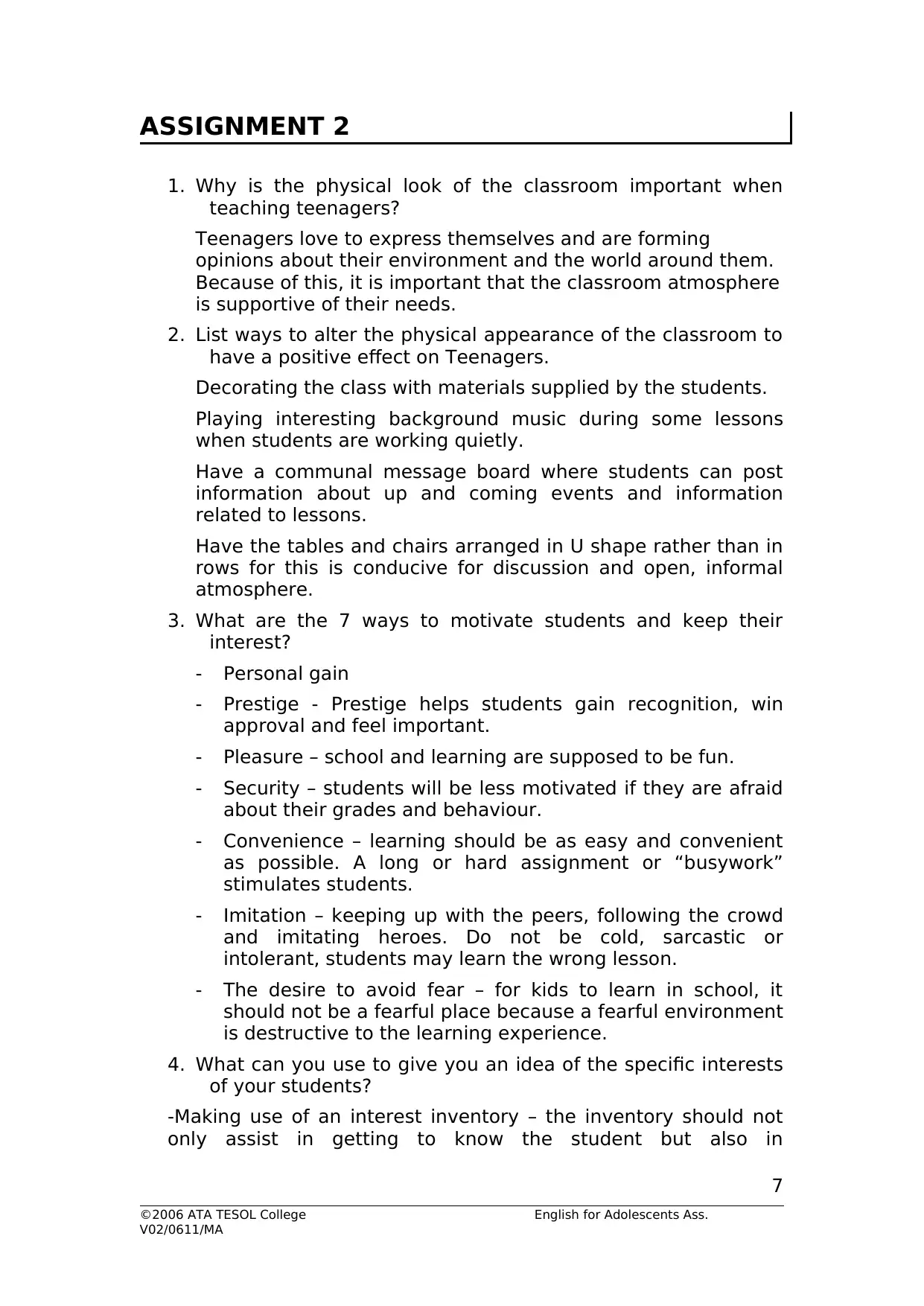
ASSIGNMENT 2
1. Why is the physical look of the classroom important when
teaching teenagers?
Teenagers love to express themselves and are forming
opinions about their environment and the world around them.
Because of this, it is important that the classroom atmosphere
is supportive of their needs.
2. List ways to alter the physical appearance of the classroom to
have a positive effect on Teenagers.
Decorating the class with materials supplied by the students.
Playing interesting background music during some lessons
when students are working quietly.
Have a communal message board where students can post
information about up and coming events and information
related to lessons.
Have the tables and chairs arranged in U shape rather than in
rows for this is conducive for discussion and open, informal
atmosphere.
3. What are the 7 ways to motivate students and keep their
interest?
- Personal gain
- Prestige - Prestige helps students gain recognition, win
approval and feel important.
- Pleasure – school and learning are supposed to be fun.
- Security – students will be less motivated if they are afraid
about their grades and behaviour.
- Convenience – learning should be as easy and convenient
as possible. A long or hard assignment or “busywork”
stimulates students.
- Imitation – keeping up with the peers, following the crowd
and imitating heroes. Do not be cold, sarcastic or
intolerant, students may learn the wrong lesson.
- The desire to avoid fear – for kids to learn in school, it
should not be a fearful place because a fearful environment
is destructive to the learning experience.
4. What can you use to give you an idea of the specific interests
of your students?
-Making use of an interest inventory – the inventory should not
only assist in getting to know the student but also in
©2006 ATA TESOL College English for Adolescents Ass.
V02/0611/MA
7
1. Why is the physical look of the classroom important when
teaching teenagers?
Teenagers love to express themselves and are forming
opinions about their environment and the world around them.
Because of this, it is important that the classroom atmosphere
is supportive of their needs.
2. List ways to alter the physical appearance of the classroom to
have a positive effect on Teenagers.
Decorating the class with materials supplied by the students.
Playing interesting background music during some lessons
when students are working quietly.
Have a communal message board where students can post
information about up and coming events and information
related to lessons.
Have the tables and chairs arranged in U shape rather than in
rows for this is conducive for discussion and open, informal
atmosphere.
3. What are the 7 ways to motivate students and keep their
interest?
- Personal gain
- Prestige - Prestige helps students gain recognition, win
approval and feel important.
- Pleasure – school and learning are supposed to be fun.
- Security – students will be less motivated if they are afraid
about their grades and behaviour.
- Convenience – learning should be as easy and convenient
as possible. A long or hard assignment or “busywork”
stimulates students.
- Imitation – keeping up with the peers, following the crowd
and imitating heroes. Do not be cold, sarcastic or
intolerant, students may learn the wrong lesson.
- The desire to avoid fear – for kids to learn in school, it
should not be a fearful place because a fearful environment
is destructive to the learning experience.
4. What can you use to give you an idea of the specific interests
of your students?
-Making use of an interest inventory – the inventory should not
only assist in getting to know the student but also in
©2006 ATA TESOL College English for Adolescents Ass.
V02/0611/MA
7
Paraphrase This Document
Need a fresh take? Get an instant paraphrase of this document with our AI Paraphraser

understanding the interest and background of the student in the
subject.
5. List 4 ways to get students involved in the teaching.
- Teamwork and discussions should be used in lessons.
- Integrate technology into teaching and learning.
- Have students participate in group and events of the school
aimed at developing a constructive and fruitful environment
for learning.
- Use clear, communication that is neither biased nor forceful
6. What are the 3 approaches for the adolescent classroom?
- Cooperative learning – peer education help students
understand, retain material and develop better
communication skills.
- Role Plays and Case Studies – students position themselves
to some place or situation. The aim of the case studies is
to develop the analytic and problem solving skills in the
students by applying what they have been taught in class.
- Questioning and discussion – This compels the students to
concentrate and be devoted to the class session
7. What is the focus of the Communicative approach? Why is it
important?
Communicative approach focuses on language learning and
the ability to apply the knowledge acquired.
Communication by the students can be achieved in many
ways.
Communication by the students for a particular objective can
be accomplished through many ways
8. What is the focus of the Integrated Skills approach?
-listening skills, reading skills, speaking skills and writing
skills.
- knowledge of vocabulary, spelling, punctuation, syntax,
meaning and usage.
9. What is the focus in the Principled Eclecticism Approach?
- Fitting the method to the learner
10. What is the 80/20 ratio in the TESOL classroom?
©2006 ATA TESOL College English for Adolescents Ass.
V02/0611/MA
8
subject.
5. List 4 ways to get students involved in the teaching.
- Teamwork and discussions should be used in lessons.
- Integrate technology into teaching and learning.
- Have students participate in group and events of the school
aimed at developing a constructive and fruitful environment
for learning.
- Use clear, communication that is neither biased nor forceful
6. What are the 3 approaches for the adolescent classroom?
- Cooperative learning – peer education help students
understand, retain material and develop better
communication skills.
- Role Plays and Case Studies – students position themselves
to some place or situation. The aim of the case studies is
to develop the analytic and problem solving skills in the
students by applying what they have been taught in class.
- Questioning and discussion – This compels the students to
concentrate and be devoted to the class session
7. What is the focus of the Communicative approach? Why is it
important?
Communicative approach focuses on language learning and
the ability to apply the knowledge acquired.
Communication by the students can be achieved in many
ways.
Communication by the students for a particular objective can
be accomplished through many ways
8. What is the focus of the Integrated Skills approach?
-listening skills, reading skills, speaking skills and writing
skills.
- knowledge of vocabulary, spelling, punctuation, syntax,
meaning and usage.
9. What is the focus in the Principled Eclecticism Approach?
- Fitting the method to the learner
10. What is the 80/20 ratio in the TESOL classroom?
©2006 ATA TESOL College English for Adolescents Ass.
V02/0611/MA
8

This refers to the ratio of student talk time which is 80% and
teacher talk time ratio of 20%.
11. Create a 45 minute lesson plan incorporating the
Communicative Approach for Upper Intermediate Teenagers.
Theme: seeking and providing for directions in London
Level and age: Upper Intermediate Teenagers
Length: 45 minutes
Special language skills: Speaking
Language goals: to improve speaking skills
Required methodology: Communicative Language Teaching
(CLT)
Specific resources: basic London central map, videos,
worksheets
Pre-task: show a basic map of London state
Teaching1 : display the map to the students and asks if they are
familiar with it
Task 1: students make guesses on the objective of the lesson
Teaching 2: show the 2 minute video clip about two people
conversing about directions where one is lost and seeking for
direction- maybe tourists
Task 2: students guided to watch the video (supplied with sub-
titles)
Teaching 3: teacher divides the students into groups with some
pretending to be tourists seeking direction
Task 3: the students take part in pairs with each learner having
handouts marked out with specific buildings that they are to
be asked about. Each of the groups takes a summary of
notes on the directions given
Follow-up: each individual from groups share with the class their findings
briefly
©2006 ATA TESOL College English for Adolescents Ass.
V02/0611/MA
9
teacher talk time ratio of 20%.
11. Create a 45 minute lesson plan incorporating the
Communicative Approach for Upper Intermediate Teenagers.
Theme: seeking and providing for directions in London
Level and age: Upper Intermediate Teenagers
Length: 45 minutes
Special language skills: Speaking
Language goals: to improve speaking skills
Required methodology: Communicative Language Teaching
(CLT)
Specific resources: basic London central map, videos,
worksheets
Pre-task: show a basic map of London state
Teaching1 : display the map to the students and asks if they are
familiar with it
Task 1: students make guesses on the objective of the lesson
Teaching 2: show the 2 minute video clip about two people
conversing about directions where one is lost and seeking for
direction- maybe tourists
Task 2: students guided to watch the video (supplied with sub-
titles)
Teaching 3: teacher divides the students into groups with some
pretending to be tourists seeking direction
Task 3: the students take part in pairs with each learner having
handouts marked out with specific buildings that they are to
be asked about. Each of the groups takes a summary of
notes on the directions given
Follow-up: each individual from groups share with the class their findings
briefly
©2006 ATA TESOL College English for Adolescents Ass.
V02/0611/MA
9
⊘ This is a preview!⊘
Do you want full access?
Subscribe today to unlock all pages.

Trusted by 1+ million students worldwide

©2006 ATA TESOL College English for Adolescents Ass.
V02/0611/MA
10
V02/0611/MA
10
Paraphrase This Document
Need a fresh take? Get an instant paraphrase of this document with our AI Paraphraser
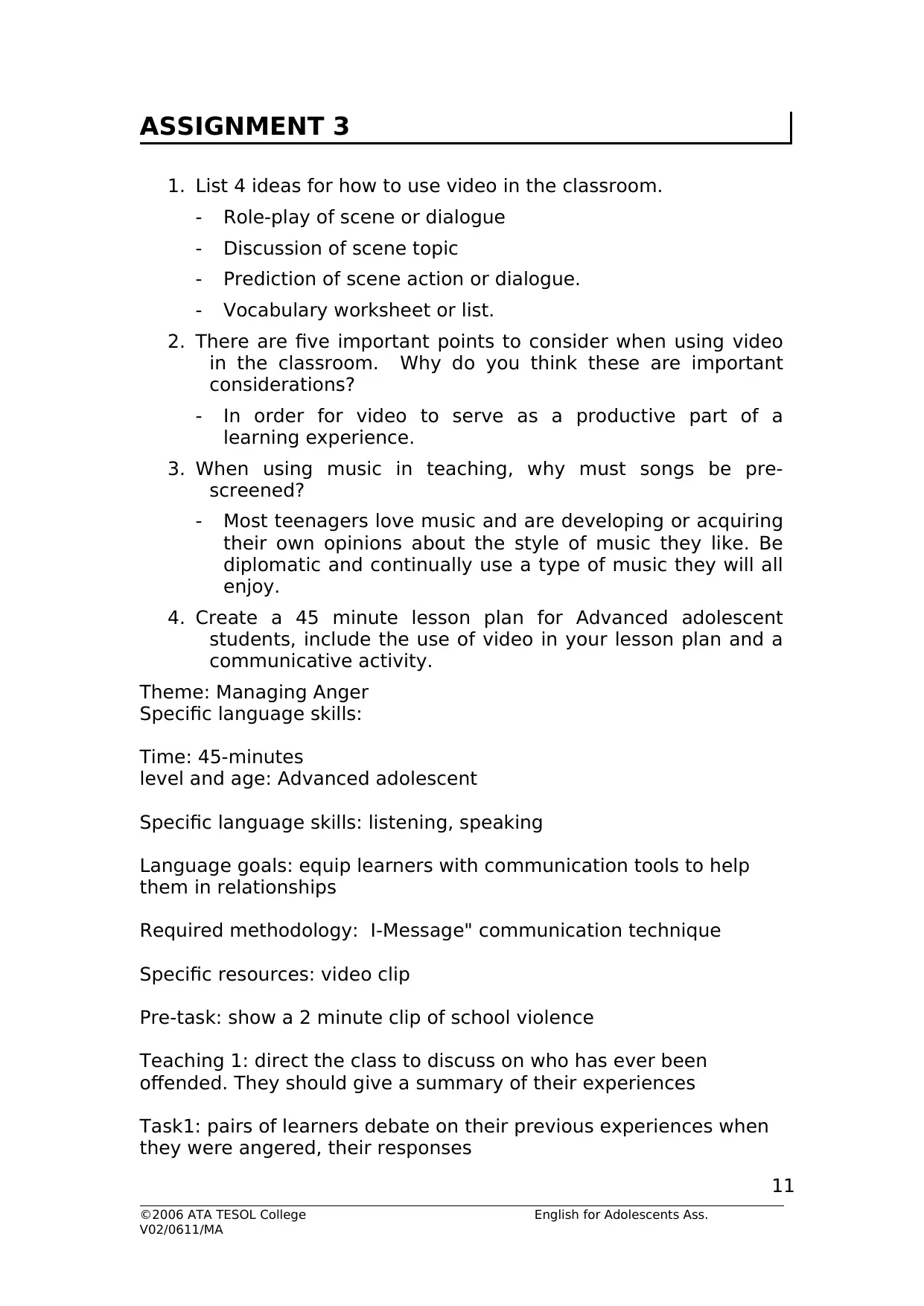
ASSIGNMENT 3
1. List 4 ideas for how to use video in the classroom.
- Role-play of scene or dialogue
- Discussion of scene topic
- Prediction of scene action or dialogue.
- Vocabulary worksheet or list.
2. There are five important points to consider when using video
in the classroom. Why do you think these are important
considerations?
- In order for video to serve as a productive part of a
learning experience.
3. When using music in teaching, why must songs be pre-
screened?
- Most teenagers love music and are developing or acquiring
their own opinions about the style of music they like. Be
diplomatic and continually use a type of music they will all
enjoy.
4. Create a 45 minute lesson plan for Advanced adolescent
students, include the use of video in your lesson plan and a
communicative activity.
Theme: Managing Anger
Specific language skills:
Time: 45-minutes
level and age: Advanced adolescent
Specific language skills: listening, speaking
Language goals: equip learners with communication tools to help
them in relationships
Required methodology: I-Message" communication technique
Specific resources: video clip
Pre-task: show a 2 minute clip of school violence
Teaching 1: direct the class to discuss on who has ever been
offended. They should give a summary of their experiences
Task1: pairs of learners debate on their previous experiences when
they were angered, their responses
©2006 ATA TESOL College English for Adolescents Ass.
V02/0611/MA
11
1. List 4 ideas for how to use video in the classroom.
- Role-play of scene or dialogue
- Discussion of scene topic
- Prediction of scene action or dialogue.
- Vocabulary worksheet or list.
2. There are five important points to consider when using video
in the classroom. Why do you think these are important
considerations?
- In order for video to serve as a productive part of a
learning experience.
3. When using music in teaching, why must songs be pre-
screened?
- Most teenagers love music and are developing or acquiring
their own opinions about the style of music they like. Be
diplomatic and continually use a type of music they will all
enjoy.
4. Create a 45 minute lesson plan for Advanced adolescent
students, include the use of video in your lesson plan and a
communicative activity.
Theme: Managing Anger
Specific language skills:
Time: 45-minutes
level and age: Advanced adolescent
Specific language skills: listening, speaking
Language goals: equip learners with communication tools to help
them in relationships
Required methodology: I-Message" communication technique
Specific resources: video clip
Pre-task: show a 2 minute clip of school violence
Teaching 1: direct the class to discuss on who has ever been
offended. They should give a summary of their experiences
Task1: pairs of learners debate on their previous experiences when
they were angered, their responses
©2006 ATA TESOL College English for Adolescents Ass.
V02/0611/MA
11
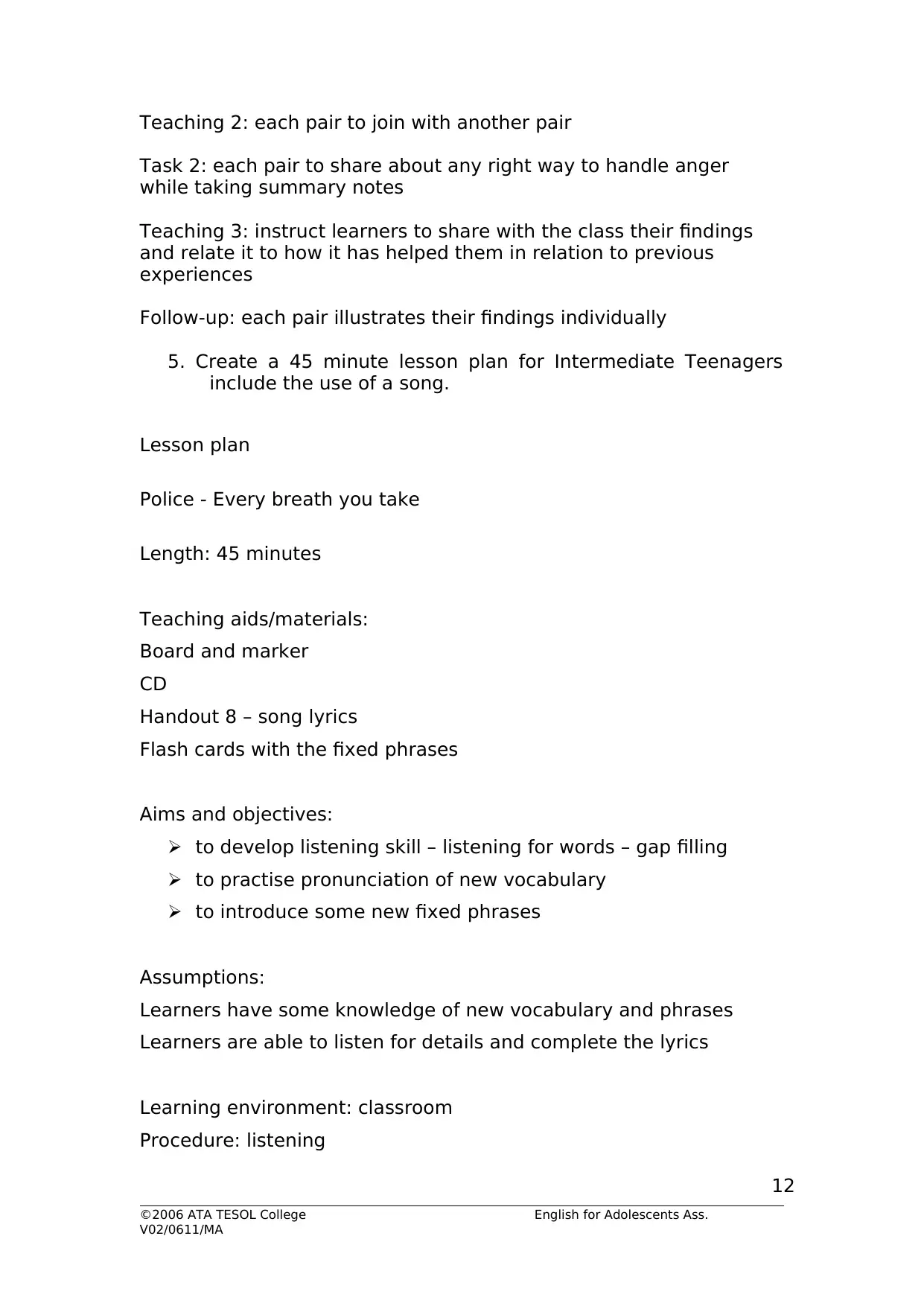
Teaching 2: each pair to join with another pair
Task 2: each pair to share about any right way to handle anger
while taking summary notes
Teaching 3: instruct learners to share with the class their findings
and relate it to how it has helped them in relation to previous
experiences
Follow-up: each pair illustrates their findings individually
5. Create a 45 minute lesson plan for Intermediate Teenagers
include the use of a song.
Lesson plan
Police - Every breath you take
Length: 45 minutes
Teaching aids/materials:
Board and marker
CD
Handout 8 – song lyrics
Flash cards with the fixed phrases
Aims and objectives:
to develop listening skill – listening for words – gap filling
to practise pronunciation of new vocabulary
to introduce some new fixed phrases
Assumptions:
Learners have some knowledge of new vocabulary and phrases
Learners are able to listen for details and complete the lyrics
Learning environment: classroom
Procedure: listening
©2006 ATA TESOL College English for Adolescents Ass.
V02/0611/MA
12
Task 2: each pair to share about any right way to handle anger
while taking summary notes
Teaching 3: instruct learners to share with the class their findings
and relate it to how it has helped them in relation to previous
experiences
Follow-up: each pair illustrates their findings individually
5. Create a 45 minute lesson plan for Intermediate Teenagers
include the use of a song.
Lesson plan
Police - Every breath you take
Length: 45 minutes
Teaching aids/materials:
Board and marker
CD
Handout 8 – song lyrics
Flash cards with the fixed phrases
Aims and objectives:
to develop listening skill – listening for words – gap filling
to practise pronunciation of new vocabulary
to introduce some new fixed phrases
Assumptions:
Learners have some knowledge of new vocabulary and phrases
Learners are able to listen for details and complete the lyrics
Learning environment: classroom
Procedure: listening
©2006 ATA TESOL College English for Adolescents Ass.
V02/0611/MA
12
⊘ This is a preview!⊘
Do you want full access?
Subscribe today to unlock all pages.

Trusted by 1+ million students worldwide
1 out of 16
Related Documents
Your All-in-One AI-Powered Toolkit for Academic Success.
+13062052269
info@desklib.com
Available 24*7 on WhatsApp / Email
![[object Object]](/_next/static/media/star-bottom.7253800d.svg)
Unlock your academic potential
Copyright © 2020–2025 A2Z Services. All Rights Reserved. Developed and managed by ZUCOL.





